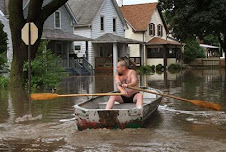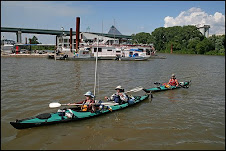

Day 18: July 5th , Vicksburg, MS
(0 River miles paddled)
Today we took a much needed zero mile day. Despite an air conditioned hotel room and a soft bed I was still up early as the river routine has my body expecting to be up and eating breakfast before sunrise. Instead of the usual oatmeal with powdered milk and dried fruit, Sarah and I walked across the street to the Fire and Ice café. I ordered the “extreme breakfast” which seemed the only logical choice for the extreme appetite that I have developed on the river. Each day we typically spend six to 10 hours paddling. I estimate that this has our bodies burning somewhere around an additional 3,000 calories per day. I ate the biscuits and gravy, eggs, sausage, toast with butter and jelly and two huge pancakes and was satisfied for the moment but found myself hungry about an hour later.
After breakfast I walked down to the waterfront to move our boats off of the Sweet Olive, a large pontoon tour boat that docked near the Vicksburg boat ramp. Ann, the owner of the boat had graciously allowed us to tie up to the stern of Sweet Olive to keep our kayaks safe at night. As I paddled the boats the short fifty feet from Sweet Olive to the boat ramp I was glad to be taking a day off from the river. It was only 7:45 am but the temperature already seemed to be in the low 90’s and climbing.
When I returned to the hotel room I called Mark Richter of the Army Corps of Engineers, Vicksburg District. The Army Corps of Engineers is responsible for building and maintaining the elaborate system of dykes and levees along the entire length of the Mississippi River. I had got in touch with Mark via email months ago to ask him questions about average river velocities in June and July. He was very helpful and seemed to take an interest in our trip. A few days ago when Sarah, Pat and I were contemplating the logistics of doing a complete food resupply in Vicksburg we pulled over on a sandbar and called Mark to ask him questions about the layout of Vicksburg. He not only was a wealth of information but offered to drive us from our hotel to do a grocery shopping run.
Mark picked us up from our hotel room and not only took us grocery shopping but also took us to the laundry mat, to his office to use the computer, made sure that we got full on ice cream, and carted all of our gear the four blocks from the hotel to the boat ramp. Mark was another example of the truly wonderful people that we have met along the way who have been so willing to lend a hand.
By the time we had loaded the boats with fresh water and our grocery resupply it was 7:30 pm and the sun was getting low in the sky. We decided to look for another hotel room and get an early start in the morning but with the holiday weekend we knew that it would be a difficult task. Just as we were getting ready to walk into town, an extremely fit couple on a tandem bicycle rode up and asked where we were paddling to and from. Doug and Margorie were both very interested in our trip as we shared the details with them. They are both kayakers themselves and frequently paddle on the Yazoo and the Mississippi. In fact the two of them actually participate in nearly every outdoor sport there is; Marjorie is a former competitive triathelete and Doug is a top ranked world class adventure racer.
When they found out that we were looking for a place to stay they told us that they owned a bed and breakfast, that they had no rooms available but that we were welcome to camp out on the floor of their parlor room. As if that offer wasn’t sweet enough, they also said that they would make us dinner and breakfast and that they couldn’t charge us. Once again we could hardly believe how helpful people can be. We eagerly took them up on their offer. The Baer House Bed and Breakfast turned out to be an unbelievably beautifully restored home built in the 1870’s. Margorie proved to be a great cook and we stayed up until past midnight talking about kayaking and swapping stories from past adventures. Vicksburg was a great rest stop.
Day 20: July 7th, Coffee Point to
Natchez, MS
(40 river miles)

Pat and I started the day by paddling out to check the five fishing lines that we had set out among the willows yesterday afternoon. It was still about 45 minutes before sunrise and the mosquitoes seemed to be getting desperate. Buzzing hordes of them swarmed every inch of our exposed skin. Within minutes we looked like measles patients. Our efforts were rewarded when we pulled up a catfish of about 3 lbs. on the end of the third line that we checked. We fried the fish up with blackening seasoning just minutes after pulling it out of the river.
When we packed up camp and hit the river it was already painfully hot. Large cumulous clouds began building on every horizon and we started hoping that they would arrive and shade us from the sun before the afternoon sun fired up.
By midday the clouds did arrive but they had turned darker and came with frequent lightning strikes. After a few hours in the sun they were still welcome even if they brought a down pour and high winds. We preferred any set of weather conditions to painfully hot and sunny. As the strong wind gusts and lightning strikes intensified we hurried to take down the mast on the water. It seemed unwise to paddle on open water with a lightning rod atop our kayak. We rafted the two kayaks together for stability and Pat cautiously stood up to take the mast apart. After the mast was down the lightning got a bit closer but never was truly close to us. We paddled hard for Natchez uncertain of how the storm would play out.
Natchez, Mississippi is the type of classic river town that we had been expecting to see but up until now we hadn’t found. It fits the image of Mark Twain’s Mississippi so well that several film versions of Huck Finn have been filmed in Natchez. It has a rich history tied to the river and is the location of the famous sandbar fight where Jim Bowie, wooded from a bullet to the hip, made the Bowie knife famous by killing a man with a 10 inch blade during a duel on a sandbar. As the story spread, sales of the “Bowie” knife increased throughout the region. The river towns have definitely become a lot less rough and tumble since those days.
After setting up camp in the public park, we spent time in the Saloon Under the Hill which was conveniently located at the top of the boat ramp. The place was covered with river memorabilia and newspaper clippings about river characters. Andre the owner of the place showed us around and he and the regular patrons of the bar spent hours telling us stories about Natchez and the river. Andre called his friend Keith, who is an avid river kayaker to come and meet us. Keith runs the Phatwater Kayak challenge, which is a 45 mile kayak race which finishes in Natchez and takes place every October. He gave us race t-shirts and a sincere invitation to come back and stay with him in October. Natchez is a great town and the three of us are strongly considering returning in the fall.

Day 23: July 10th, Ratcliff Landing to Point Menoir
(34 river miles)
It was another hot day on the river. We were ready to pack it in for the day but couldn’t find land to camp on. The high water has made landing sites in short supply throughout our trip. We paddled out of a chute and in the distance on the opposite side of the river we spotted a house with a large grassy yard on the opposite side of the river. It was less than a mile and a half away and we paddled hard to cross the river in such a short distance.
As we paddled up to the yard we could see an impressive house with an expansive view of the river. We got out of the boats and I walked up to the house to ask permission to camp in the yard. A truck pulled up in the driveway and a large man and his full grown boxer stepped out. Glynn, a former semi pro football player, and his barking dog seemed a bit intimidating at first but as soon as I had introduced myself he was quick to welcome us to Wildwood plantation. The land had been in his family since the 1700’s. Although Glynn owns a construction company there is still some farming that goes on at the plantation. Glynn sat and talked with us about the history of the plantation for a few hours. He invited us into his home to clean up and to show us his hunting trophies including an alligator more than 11 feet long. When we asked if we could take his picture with the alligator he grinned and decided to entertain us by hamming it up for the camera. He quickly donned his camouflage and posed in front of the gator with an empty bottle of wine and a machine gun. I didn’t ask if the gun was loaded.
We spent the end of the day swimming in Glynn’s p00l and watching the sunset over the river.
Day 26: July 13, Donaldsonville Boat Ramp to
Bonnett Carre Spillway
(47 river miles)

By this point the river has become an industrial corridor. Nearly all of the time that we are on the water we are constantly scanning the horizon around every bend in the river looking for barges and ocean going cargo ships hundreds of feet long. Lining each bank there are barges tied up that make it difficult to spot moving barges as they blend in with the anchored ships. At one point today Sarah and I were coming around a bend and sailing towards what we thought was an anchored cargo ship. As we got closer the ship, which had been holding up for a passing barge, it began to throttle up again and quickly move in our direction. As we dropped the sail to paddle hard for the left bank, the ship’s pilot laid on the horn to further motivate us. Although it seemed close, we broke into a full speed paddle and easily cleared the ships bow by more than a hundred yards. Dodging barges and ships is just part of our routine since we passed below Baton Rouge
Day 27: July 14, Bonnett Carre Spillway to
New Orleans, Louisiana
(34 river miles)
We made it! As we got closer to New Orleans, nearly every barge and tug captain waved to us or gave us a thumbs up. One tug crew tossed us cold cokes and let Sarah come aboard to use the bathroom.
When we got close to the city, people all along the river bank waved to us. For the last half mile we even had a soundtrack as a woman playing a pipe organ atop a paddle boat played Row Row Row Your Boat in our honor. We clapped wildly at the end of the song and she stood up and took a bow.
We pulled up to a short set of wooden steps directly in front of the St. Louis Cathedral. It was the perfect place to end our journey. As we took photos and packed up our gear and boats we talked to dozens of people who passed by and congratulated us on reaching New Orleans. It has been a great trip and its now time to celebrate.













































